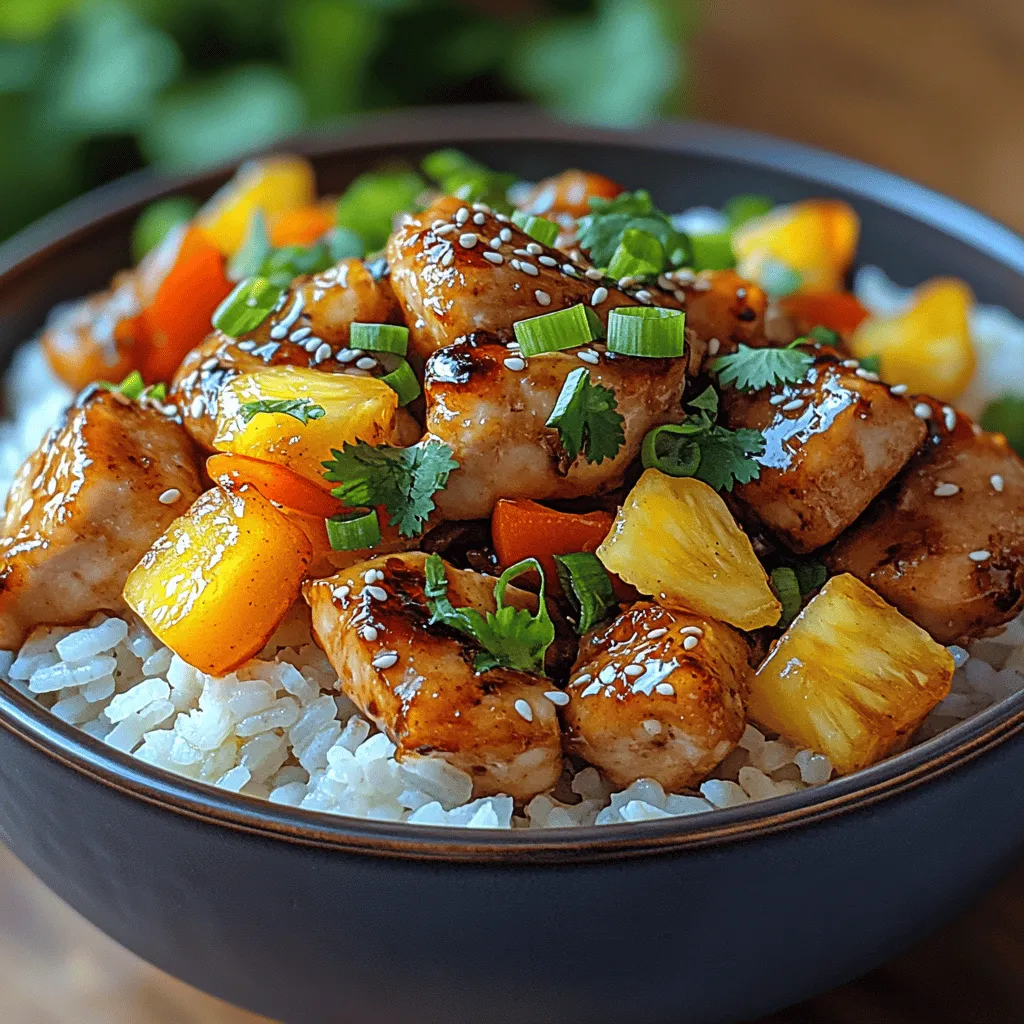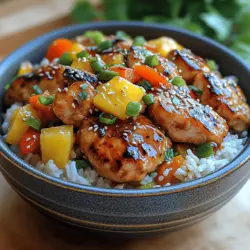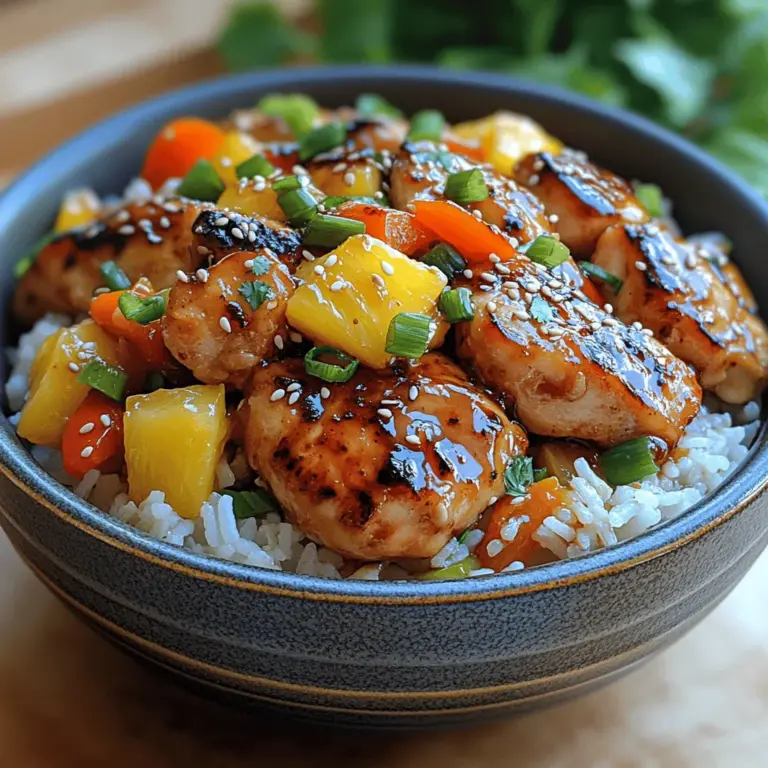Introduction
If you’re searching for a vibrant and flavorful dish that brings together the sweetness of pineapple, the savory depth of teriyaki sauce, and the crunch of fresh vegetables, look no further than Teriyaki Pineapple Chicken & Rice Peppers. This delightful recipe is not only visually appealing but also a harmonious blend of flavors that will have your taste buds dancing. Perfect for family dinners, gatherings with friends, or even meal prep for the week, this dish is versatile enough to satisfy everyone at the table.
The combination of tender chicken, juicy pineapple, and colorful bell peppers creates a beautiful medley of textures and tastes. The sticky, rich teriyaki sauce elevates each component, making every bite a delightful experience. Whether you’re a seasoned cook or a kitchen novice, this recipe is straightforward and quick to prepare, ensuring you can serve a crowd-pleasing meal without spending hours in the kitchen.
Understanding Teriyaki Cuisine
Origin of Teriyaki Sauce and Its Cultural Significance
Teriyaki, which translates to “glossy grill,” has its roots in Japanese cuisine, where it has been enjoyed for centuries. The traditional method involves grilling or broiling meat or fish, brushed with a sweet soy sauce-based marinade. Over time, teriyaki sauce has gained popularity worldwide, evolving to suit various palates and culinary styles. Its rich flavor profile, combining sweet, salty, and umami notes, has made it a favorite in many kitchens.
The cultural significance of teriyaki cuisine extends beyond just its flavor. It represents a fusion of Japanese cooking techniques with local ingredients and preferences, leading to diverse interpretations of this classic dish. Today, you can find teriyaki chicken, beef, and even tofu variations, making it an adaptable choice for various dietary needs.
Common Ingredients in Teriyaki Dishes
The hallmark of teriyaki dishes lies in their foundational ingredients, which typically include soy sauce, sake, mirin, and sugar. These components come together to create a balanced sauce that enhances the natural flavors of the main protein while providing a glossy finish. In addition to the sauce, teriyaki dishes often feature fresh vegetables and rice, making them well-rounded meals.
Health Benefits of Incorporating Teriyaki into Meals
Incorporating teriyaki into your meals can offer several health benefits, particularly when using fresh ingredients. Chicken, for instance, is a lean protein packed with essential nutrients like B vitamins and selenium. Pineapple adds a dose of vitamins C and B6, along with digestive enzymes that can aid in digestion. When prepared with an abundance of vegetables and served with whole grains like jasmine rice, teriyaki dishes become not only delicious but also nutritionally balanced.
Moreover, utilizing homemade teriyaki sauce allows you to control the ingredients and adjust the sugar content, making it a healthier option compared to many store-bought varieties, which often contain preservatives and artificial flavors.
Ingredient Breakdown
To create the perfect Teriyaki Pineapple Chicken & Rice Peppers dish, it’s essential to understand the role of each ingredient. Here’s a detailed breakdown:
Chicken: Nutritional Benefits and Cooking Tips
Chicken is the star of this recipe, offering a protein-packed base that is both satisfying and versatile. It’s a great source of lean protein, making it a favorite among health-conscious individuals. Additionally, chicken is rich in essential nutrients such as niacin, which helps with metabolism, and phosphorus, which is crucial for healthy bones.
When preparing chicken for this dish, boneless, skinless chicken thighs or breasts work best. Thighs offer a bit more fat, enhancing flavor and tenderness, while breasts provide a leaner option. For optimal results, marinate the chicken for at least 30 minutes, allowing it to soak up the teriyaki flavors before cooking.
Pineapple: Sweetness and Health Properties
Pineapple brings a tropical sweetness to the dish, balancing the savory flavors of the teriyaki sauce. This fruit is not only delicious but also packed with nutrients. Pineapple is an excellent source of vitamin C, manganese, and dietary fiber, making it a smart addition to any meal.
In this recipe, fresh pineapple chunks are used to provide a burst of flavor and juiciness. When selecting a pineapple, look for one that is slightly soft to the touch with a sweet aroma at the base. If fresh pineapple is unavailable, canned pineapple in its juice can be a suitable substitute, though fresh is always recommended for the best flavor.
Teriyaki Sauce: Differences Between Homemade and Store-Bought
Teriyaki sauce is the key ingredient that unites all components of this dish. While store-bought varieties are convenient, making your own sauce allows for customization and a fresher taste. A basic homemade teriyaki sauce consists of soy sauce, sake, mirin, sugar, and ginger. This combination provides a rich, glossy finish that elevates the chicken and vegetables.
When opting for store-bought teriyaki sauce, choose one that has minimal additives and preservatives. Reading the label can help you avoid options high in sugar and sodium, aligning with healthier eating practices.
Bell Peppers: Nutritional Values and Color Variations
Bell peppers are not only colorful but also packed with nutrients, adding both aesthetic appeal and health benefits to the dish. They are an excellent source of vitamins A and C, potassium, and dietary fiber. The different colors of bell peppers—red, yellow, and green—offer slightly different flavors, with red being the sweetest and green having a more bitter taste.
In this recipe, a mix of bell peppers not only provides a range of flavors but also creates a visually stunning presentation. When preparing bell peppers, be sure to wash them thoroughly, remove the seeds and stems, and slice them into bite-sized pieces for even cooking.
Jasmine Rice: Why It’s the Best Choice for This Dish
Jasmine rice is the perfect accompaniment to Teriyaki Pineapple Chicken & Rice Peppers. This long-grain rice is known for its fragrant aroma and slightly sticky texture, which complements the saucy chicken and vegetables beautifully. Jasmine rice cooks up fluffy and tender, providing a satisfying base for the dish.
In addition to its delicious flavor, jasmine rice is a good source of carbohydrates, providing the energy needed for a busy day. When cooking jasmine rice, it’s essential to rinse it before cooking to remove excess starch, which can lead to a gummy texture.
Garnishes: Importance of Green Onions, Sesame Seeds, and Cilantro
No dish is complete without the right garnishes to elevate its presentation and flavor. For this Teriyaki Pineapple Chicken & Rice Peppers, finely chopped green onions add a fresh, mild onion flavor that contrasts beautifully with the sweetness of the pineapple and the richness of the teriyaki sauce.
To enhance the dish further, sprinkle a handful of sesame seeds for a nutty crunch, and consider adding fresh cilantro for a burst of herbal freshness. These garnishes not only enhance the flavor but also add an appealing visual element, making the dish even more inviting.
Preparation Steps Explained
Marinating the Chicken
Marinating the chicken is the first crucial step in preparing this dish. Not only does it infuse the chicken with the delicious flavors of teriyaki, but it also helps to tenderize the meat. To marinate the chicken, combine your homemade or store-bought teriyaki sauce with the chicken in a sealable plastic bag or a shallow dish. Ensure the chicken is well-coated in the marinade, then seal the bag or cover the dish and refrigerate.
For optimal flavor, allow the chicken to marinate for at least 30 minutes, though marinating for an hour or more will yield even better results. This marination process is essential, as it allows the flavors to penetrate the meat, resulting in a truly mouthwatering dish when cooked.
As you prepare to marinate, consider setting aside a small amount of the teriyaki sauce for later use. This reserved sauce can be used to glaze the chicken during cooking or as an additional drizzle over the finished dish for extra flavor.
By understanding the components and preparation steps involved in making Teriyaki Pineapple Chicken & Rice Peppers, you’re well on your way to creating a meal that is not only delicious but also a feast for the eyes. Stay tuned for the next part, where we will dive deeper into the cooking process and share tips for achieving the best results.

Ideal Marination Times for Optimum Taste
Marination is a crucial step in preparing Teriyaki Pineapple Chicken & Rice Peppers, as it infuses the chicken with rich flavors. For optimal taste, marinate the chicken for at least 30 minutes. However, for deeper flavor penetration, aim for 1 to 2 hours, or even overnight in the refrigerator. The longer you marinate, the more pronounced the savory and sweet notes of the teriyaki sauce will become. Just remember to keep the marinated chicken covered and refrigerated to maintain food safety.
Sautéing the Vegetables
Once your chicken is marinated, it’s time to prepare the vegetables. Heat a tablespoon of oil in a large skillet or wok over medium-high heat. Add the sliced bell peppers and sauté for about 3 to 4 minutes. You want them to be tender yet still retain some crunch. This quick cooking method helps preserve their bright colors and enhances their natural sweetness, making them the perfect complement to the savory chicken.
Best Practices for Maintaining the Crispness of Bell Peppers
To maintain the desired crispness of your bell peppers, avoid overcrowding the pan. Cook in batches if necessary, allowing enough space for the vegetables to sauté evenly. Additionally, limit the cooking time; overcooked bell peppers can turn mushy and lose their vibrant hues. A splash of cold water can be added to the pan towards the end of cooking to create steam, which will help them cook through without losing their crunch.
Flavor Pairing with Salt and Pepper
While the teriyaki sauce is the star of this dish, don’t forget the importance of seasoning. A pinch of salt and freshly cracked black pepper can enhance the overall flavor profile. Season the sautéed vegetables lightly after they have been cooked, as this will help to bring out their natural sweetness and balance the flavors.
Cooking the Chicken
After the vegetables are ready, it’s time to cook the marinated chicken. In the same skillet, add a bit more oil if necessary and heat it over medium-high heat. Add the chicken pieces, making sure not to overcrowd the pan to achieve a good sear. Cook the chicken for about 5 to 7 minutes or until it is golden brown and cooked through. The internal temperature should reach 165°F (75°C) to ensure it is safe to eat.
Techniques for Achieving a Perfect Caramelization
Caramelization is key to developing rich flavors in your chicken. To achieve this, allow the chicken to sit undisturbed for a couple of minutes after placing it in the pan. This will help create a golden crust. Once seared, you can stir the chicken occasionally to ensure even cooking and browning. If you find that the chicken is browning too quickly, lower the heat slightly to prevent burning.
Timing for Adding Pineapple for Optimal Flavor Release
Pineapple is a crucial ingredient that adds sweetness and acidity to the dish. To optimize its flavor release, add the pineapple chunks to the skillet about 2 to 3 minutes before the chicken is fully cooked. This timing allows the pineapple to soften slightly while also caramelizing and releasing its natural sugars, which will enhance the overall taste of the dish.
Combining with Rice
Once your chicken and vegetables are ready, it’s time to combine everything with the rice. Add the cooked rice directly into the skillet with the chicken, vegetables, and pineapple. Gently fold the mixture together to ensure that the rice is evenly distributed and coated with the teriyaki sauce.
Tips for Ensuring Rice is Evenly Coated with Sauce
To ensure that the rice is evenly coated with the sauce, consider using cold, day-old rice. Freshly cooked rice can be sticky and clump together, making it harder to separate and mix thoroughly with the other ingredients. If using fresh rice, spread it out on a baking sheet to cool for a few minutes before adding it to the skillet. Additionally, drizzle a bit more teriyaki sauce over the rice mixture and stir gently to distribute the flavors evenly.
The Role of Heat in Blending Flavors
Maintaining the right level of heat is essential when combining the rice and other ingredients. Use medium heat to allow the flavors to meld together without overcooking the rice. Stir the mixture frequently for about 3 to 5 minutes until everything is heated through and well combined. This gentle cooking will help to marry the sweet, savory, and tangy flavors of the teriyaki sauce, chicken, and vegetables.
Serving Suggestions
Plating the Dish for Visual Appeal
When it comes to serving Teriyaki Pineapple Chicken & Rice Peppers, presentation is key. Use a large serving platter or individual bowls for an elegant touch. Start by placing a generous portion of the rice mixture at the center, then arrange the sautéed chicken and bell peppers on top. Garnish with fresh chopped green onions or sesame seeds for added texture and color.
Pairing Ideas: Recommended Side Dishes and Beverages
This dish pairs wonderfully with a variety of side dishes. Consider serving it alongside a fresh cucumber salad or steamed edamame for a light and refreshing contrast. For a more substantial meal, you can serve it with crispy spring rolls or miso soup. As for beverages, a chilled sake or a light, fruity white wine can complement the flavors beautifully.
Variations: Suggestions for Customizing the Recipe
The beauty of Teriyaki Pineapple Chicken & Rice Peppers lies in its versatility. Feel free to customize the recipe by swapping out proteins. For instance, shrimp, tofu, or even tempeh can be excellent alternatives. You can also experiment with different vegetables, such as snap peas, broccoli, or carrots, depending on your preference or what you have on hand. Additionally, consider varying the sweetness of the dish by using different types of teriyaki sauce or adding a splash of chili sauce for a spicy kick.
Nutritional Information
A serving of Teriyaki Pineapple Chicken & Rice Peppers typically contains approximately 450 calories, with about 30 grams of protein, 10 grams of fat, and 60 grams of carbohydrates. This meal provides a balanced combination of macronutrients, making it a healthy choice for any day of the week. The inclusion of chicken offers lean protein, while pineapple introduces essential vitamins and minerals. The colorful bell peppers contribute antioxidants and dietary fiber, promoting overall health.
Benefits of a Balanced Meal Featuring Protein, Fruits, and Vegetables
This dish is not only delicious but also nutritionally balanced. The protein from the chicken helps to build and repair tissues, while the fruits and vegetables provide vital nutrients that support immune function and digestive health. Moreover, the combination of protein, carbohydrates, and fiber can help keep you feeling satisfied and energized throughout the day.
Conclusion
Teriyaki Pineapple Chicken & Rice Peppers is a delightful fusion of flavors that brings together the savory, sweet, and tangy elements of teriyaki sauce with the refreshing taste of pineapple and crisp vegetables. This dish not only tantalizes your taste buds but also encourages creativity in the kitchen, allowing you to customize it to suit your preferences.
By following the steps outlined in this recipe, you can create a meal that not only impresses but also brings family and friends together around the dinner table. Whether you opt for chicken, shrimp, or tofu, the combination of flavors and textures will undoubtedly create a memorable dining experience. So why not gather your ingredients, try your hand at this easy-to-make recipe, and enjoy the delightful flavors that Teriyaki Pineapple Chicken & Rice Peppers has to offer?


